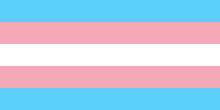Kathoey

| Part of a series on |
| Transgender topics |
|---|
 |
| Identities |
| Topics |
| Attitudes |
| Legal issues |
| Lists |
|
|
Kathoey or katoey (Thai: กะเทย; rtgs: Kathoei [kàtʰɤːj]) is a Thai term that refers to either a transgender woman or an effeminate gay male in Thailand. A significant number of Thais perceive kathoeys as belonging to a third gender, including many kathoeys themselves, while others see them as either a kind of man or a kind of woman.[1] However, when considering transgender women (MtF) as a group in Thai society, most refer to themselves as phuying (Thai: ผู้หญิง "women"), with a minority referring to themselves as phuying praphet song (a "second kind of woman") and only very few referring to themselves as kathoey.[2] Related phrases include phet thi sam (Thai: เพศที่สาม, "third gender"), and sao praphet song or phu ying praphet song (Thai: สาวประเภทสอง, ผู้หญิงประเภทสอง— both meaning "second-type female"). The word kathoey is of Khmer origin.[3] It is most often rendered as ladyboy or lady boy in English conversation with Thais and this latter expression has become popular across Southeast Asia.
General description
Although kathoey is often translated as "transgender" in the English usage, this term is not used frequently in Thailand. As well as trans individuals, the term can refer to gay men, and was originally used to refer to intersex individuals. Because of this confusion in translation, the English translation of kathoey is usually "ladyboy" (or variants of the term).
Use of the term "kathoey" suggests that the person self-identifies as a type of male, in contrast to sao praphet song (which, like "trans woman", suggests a "female" (sao) gender identity), and in contrast to phet thi sam (which means "third gender"). The term phu ying praphet song, which can be translated as "second-type female", is also used to refer to kathoey.[4] Australian scholar of sexual politics in Thailand Peter Jackson claims that the term "kathoey" was used in pre-modern times to refer to intersex people, and that the usage changed in the middle of the twentieth century to cover cross-dressing males.[5] The term can refer to males who exhibit varying degrees of femininity. Many kathoeys dress as women and undergo "feminising" medical procedures such as breast implants, hormones, silicone injections, or Adam's apple reductions. Others may wear makeup and use feminine pronouns, but dress as men, and are closer to the Western category of effeminate gay man than transgender.
The term "kathoey" may be considered pejorative, especially in the form "kathoey-saloey". It has a meaning similar to the English language "fairy" or "queen".[6]
Social context
Many kathoey work in predominately female occupations, such as in shops, restaurants, and beauty salons, but also in factories (a reflection of Thailand's high proportion of female industrial workers).[7] Kathoey also work in entertainment and tourist centers, in cabarets, and as sex workers. Kathoey sex workers have high rates of HIV.[8]
Kathoeys are more visible and more accepted in Thai culture than transgender people are in other countries in the world. Several popular Thai models, singers and movie stars are kathoeys, and Thai newspapers often print photos of the winners of female and kathoey beauty contests side by side. The phenomenon is not restricted to urban areas; there are kathoeys in most villages, and kathoey beauty contests are commonly held as part of local fairs.
Using the notion of Karma, some Thai believe that being a kathoey is the result of transgressions in past lives, concluding that kathoey deserve pity rather than blame.[9]
A common stereotype is that older, well-off kathoey provide financial support to young men with whom they are in a personal relationship.[10]
Kathoeys currently face many social and legal impediments. Families (and especially fathers) are typically disappointed if a child becomes a kathoey, and kathoeys often have to face the prospect of coming out. However, kathoey generally have greater acceptance in Thailand than most other Asian countries.[11] Legal recognition of kathoeys and transgender individuals is non-existent in Thailand: even if trans people have had genital reassignment surgery, they are not allowed to change their legal sex. Discrimination in employment also remains rampant.[12] Problems can also arise in regards to access to amenities and gender allocation; for example, a kathoey and a transgender person who has undergone sexual reassignment surgery would still have to stay in an all-male prison.
Recent developments

In 1993, Thailand's teacher training colleges implemented a semi-formal ban on allowing homosexual (which included kathoey) students enrolling in courses leading to qualification for positions in kindergartens and primary schools. In January 1997, the Rajabhat Institutes (the governing body of the colleges) announced it would formalize the ban, which would extend to all campuses at the start of the 1997 academic year. The ban was quietly rescinded later in the year, following the replacement of the Minister of Education.[13]
In 1996, a volleyball team composed mostly of gays and kathoeys, known as The Iron Ladies (Thai: สตรีเหล็ก, satree lek), later portrayed in two Thai movies, won the Thai national championship. The Thai government, concerned with the country's image, barred two of the kathoeys from joining the national team and competing internationally.
Among the most famous kathoeys in Thailand is Nong Tum, a former champion Thai boxer who emerged into the public eye in 1998. She would present in a feminine manner and had commenced hormone therapy while still a popular boxer; she would enter the ring with long hair and makeup, occasionally kissing a defeated opponent. She announced her retirement from professional boxing in 1999 – undergoing genital reassignment surgery, while continuing to work as a coach, and taking up acting and modeling. She returned to boxing in 2006.
In 2004, the Chiang Mai Technology School allocated a separate restroom for kathoeys, with an intertwined male and female symbol on the door. The 15 kathoey students are required to wear male clothing at school but are allowed to sport feminine hairdos. The restroom features four stalls, but no urinals.[14]
Following the 2006 Thai coup d'état, kathoeys are hoping for a new third sex to be added to passports and other official documents in a proposed new constitution.[15] In 2007, legislative efforts have begun to allow kathoeys to change their legal sex if they have undergone genital reassignment surgery; this latter restriction was controversially discussed in the community.[12]
Bell Nuntita, a contestant of Thailand's Got Talent TV shows, became a YouTube hit when she first performed singing as a girl, and then switched to a masculine voice.[16]
In popular culture
The first all kathoey music group in Thailand was formed in 2006. It is named Venus Flytrap and was selected and promoted by Sony BMG Music Entertainment.[17] The Lady Boys of Bangkok is a kathoey revue that has been performed in the UK since 1998 touring the country in both theatres and the famous "Sabai Pavilion" for nine months each year.
Ladyboys is a 1992 documentary film made for Channel 4 TV and directed by Jeremy Marre. It relates the story of two teenage kathoey who prepare for and enter a rural beauty contest and then leave for Pattaya to find work in a cabaret revue.
See also
References
- ↑ Winter, Sam (2003). Research and discussion paper: Language and identity in transgender: gender wars and the case of the Thai kathoey. Paper presented at the Hawaii conference on Social Sciences, Waikiki, June 2003. Article online.
- ↑ BSc, Sam Winter (2006-06-14). "Thai Transgenders in Focus: Demographics, Transitions and Identities". International Journal of Transgenderism. 9 (1): 15–27. doi:10.1300/J485v09n01_03. ISSN 1553-2739.
- ↑ Jackson, Peter A. (April 1996). "Non-normative Sex/Gender Categories in the Theravada Buddhist Scriptures". Retrieved 5 December 2009.
- ↑ Jackson, Peter (1999). Lady Boys, Tom Boys, Rent Boys: Male and Female Homosexualities in Contemporary Thailand. Haworth Press. p. 146. ISBN 0-7890-0656-1.
- ↑ Jackson, Peter (2003). Performative Genders, Perverse Desires: A Bio-History of Thailand's Same-Sex and Transgender Cultures. in "Intersections: Gender, History and Culture in the Asian Context," Issue 9, August 2003. See paragraph "The Homosexualisation of Cross-Dressing."
- ↑ CPAmedia.com: Thailand's Women of the Second Kind
- ↑ Winter S, Udomsak N (2002). Male, Female and Transgender: Stereotypes and Self in Thailand. International Journal of Transgenderism. 6,1
- ↑ "HIV-Related Risk Behaviors among Kathoey (Male-to-Female Transgender) Sex Workers in Bangkok, Thailand". AIDS Care. 24 (2): 210–9. 2012. doi:10.1080/09540121.2011.597709. PMC 3242825
 . PMID 21780964.
. PMID 21780964. - ↑ Totman, Richard (2003). The Third Sex: Kathoey: Thailand's Ladyboys. London: Souvenir Press. p. 57. ISBN 0-285-63668-5.
- ↑ Thailand, in the International Encyclopedia of Sexuality, Volume I–IV 1997–2001, edited by Robert T. Francoeur
- ↑ Roderick, Daffyd (2001). "Boys Will Be Girls: In a Bangkok clinic, $1,000 can turn a man into a woman. Some call that the price of freedom". TIMEasia.com. Time Asia. Archived from the original on 13 April 2001. Retrieved 22 March 2015.. See also Céline Grünhagen: Transgender in Thailand: Buddhist Perspectives and the Socio-Political Status of Kathoeys. In: Gerhard Schreiber (ed.), Transsexuality in Theology and Neuroscience. Findings, Controversies, and Perspectives. De Gruyter, Berlin and Boston 2016, pp. 219-232.
- 1 2 Are you man enough to be a woman? Bangkok Post, 1 October 2007
- ↑ Jackson, Peter (1999). Lady Boys, Tom Boys, Rent Boys: Male and Female Homosexualities in Contemporary Thailand. Haworth Press. pp. xv–xiv. ISBN 0-7890-0656-1.
- ↑ "Transvestites Get Their Own School Bathroom", Associated Press, 22 June 2004.
- ↑ "Thailand’s 'third sex' seeks legal recognition". The First Post. 17 May 2007.
- ↑ Winn, Patrick (16 March 2011). "UPDATED: Thai transgender talent show shocker = YouTube gold". globalpost. Retrieved 22 March 2015.
- ↑ "‘Katoeys’ hit the music scene", The Star, 3 February 2007.
External links
| Wikimedia Commons has media related to Kathoeys. |
| Look up kathoey in Wiktionary, the free dictionary. |
- Andrew Matzner, In Legal Limbo: Thailand, Transgendered Men, and the Law, 1999. Criticizes the common view that kathoey are fully accepted by Thai society.
- Andrew Matzner, Roses of the North: The Katoey of Chiang Mai University, 1999. Reports on a kathoey "sorority" at Chiang Mai University.
- Transgender Asia including several articles on kathoey
- Where the 'Ladyboys' Are
- Ladyboy: Thailand's Theater of Illusion. Chiang Mai, Cognoscenti Books, 2012. ASIN: B0085S4WQC
- Can you tell the difference between Katoeys and real ladies?"
- E.G. Allyn: Trees in the Same Forest, 2002. Description of the gay and kathoey scene of Thailand.
- Chanon Intramart and Eric Allyn, Beautiful Boxer, 2003. Describes the story of Nong Tum.
- The Hermaphrodite World is a film exploring the kathoey culture of Thailand
- Katoey Thai-Ladyboys
- Farrell, James Austin. "The price of change and the right to be a woman in Thailand", Asian Correspondent, 2015-12-14.
